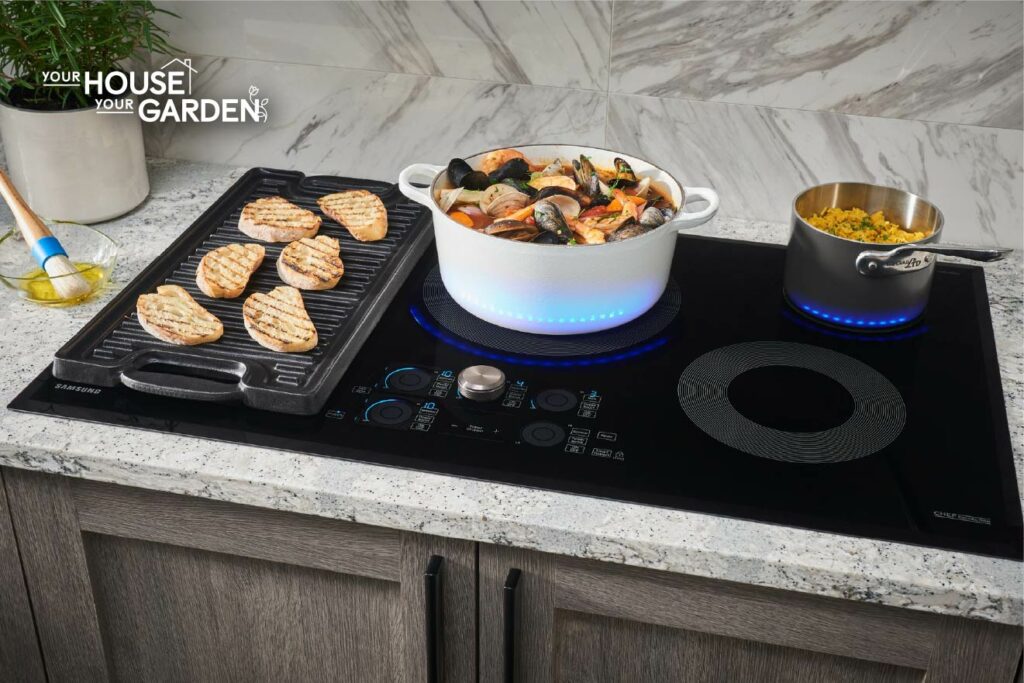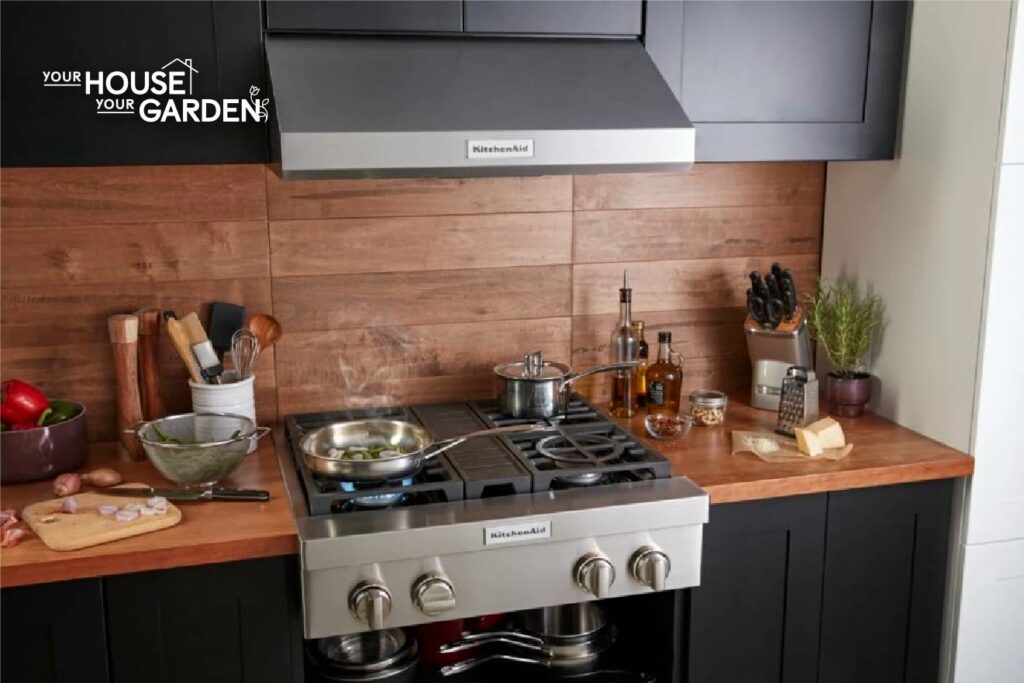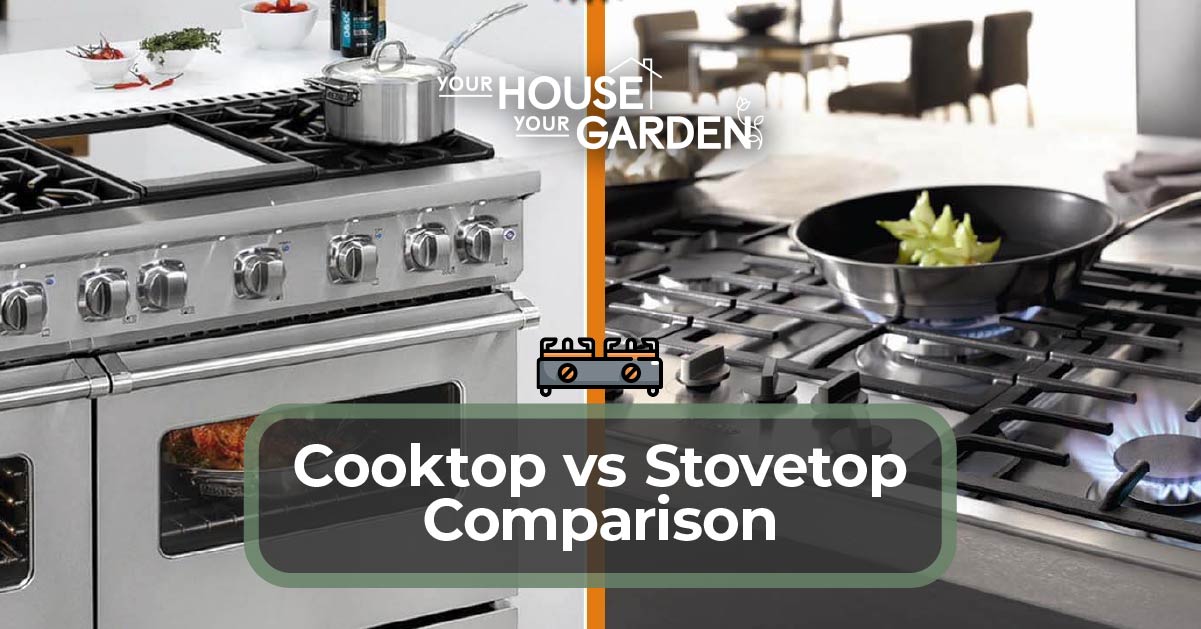Are you remodeling your kitchen or moving into a new home and considering whether to get a cooktop or a stovetop? You’re in the right place!
These appliances do the same thing – cook your food. And the essence of a cooktop and a stovetop is to save space in the kitchen as none come with an oven. You can install them over built-in ovens or in kitchen islands.
While they seem so similar, there are subtle differences that you may not know exists: hence, the need for this cooktop vs stovetop comparison guide.
To help you make an informed decision, we’ll explore the features of cooktops and stovetops. So let’s find out the differences between a stovetop and a cooktop.
Differences between A Cooktop vs A Stovetop
The major difference between a cooktop and a stovetop is in the position of their control panels.
A cooktop has its control panel on its surface, thereby reducing the space taken up by the cooking area. Conversely, a stovetop has its control panel across its face (at the front) and affords you more room to do your cooking.
The second major difference between a cooktop and a stovetop is in their installation.
A cooktop is installed by dropping the appliance into a space specifically cut out to its fitting on the countertop – this way, the appliance is flanked on three or all four sides by the countertop. A stovetop is installed by sliding the appliance into the countertop such that it’s flanked on its right and left sides by the countertop.
To better understand how a cooktop differs from a stovetop, we’ll explore both appliances individually.
What is a cooktop? A cooktop is a kitchen appliance that comes without an oven and has its control knobs or panel on its cooking surface. It is installed as a drop-in unit in a precisely cut-out space on the countertop such that it’s surrounded on its three or all four sides by the countertop.
Cooktops tend to be small as they’re installed in a hole cut out from the countertop rather than in an entire cut-out section. This makes them good for small kitchens with small countertop space. But this results in a limited cooking area, so you may not be able to cook for a large number of people at a time.
Also, the top surface placement of the control features makes a cooktop one of the safest appliances for homes with kids as they can’t reach the top. A cooktop is not so powerful as it has fewer power burners, but it’s a great appliance for the modern cook to have.
What is a stovetop? A stove top, also called a range top, is a cooking appliance that is also without an oven underneath it. However, they have their control panels in front as opposed to their top.
To be clear, a stove is the same appliance as a range – cooking units that come with both the rangetop and oven as one unit as opposed to having a cooktop and an oven as different units. So stoves and ranges can be used interchangeably.
For those who often host parties or a large number of guests on weekends, a stovetop is an ideal appliance as it gives you a larger cooking area. Also, a rangetop is more durable and professional-styled as it comes loaded with more features and powerful burners for heavy-duty cooking.
Furthermore, stovetops are large, so they take up an entire cut-out section such that they’re only bordered by the countertop on two sides. The downside is that they may be too bulky for a small kitchen. While their front control feature installation makes them easily accessible by chefs, they are not so safe for homes with kids.
Superiorities of a cooktop to a stovetop
The benefits of owning a cooktop as opposed to a stovetop are their space-saving and safety features, cheaper price, and ease of cleaning. When compared to cooktops, stovetops are more budget-friendly and are a better fit for households with small kitchens. They’re also easier to clean and are safer for homes with kids.
Great for small kitchens
Both cooktops and stovetops are great space savers due to the absence of ovens. However, if you have a small kitchen, installing a cooktop will be more ideal as it’s smaller than a range top. Due to their smaller sizes, they’re installed as drop-in units in a hole carved out on the countertop. Here are the use cases of cooktops.
On the other hand, a rangetop requires a larger installation area which may make them seem bulky for a small kitchen – A whole portion of the countertop needs to be completely cut out from the front to the back. So they’re installed as slide-in units rather than drop-ins.
More affordable cooker
When compared to a stovetop, a cooktop is more affordable. The price for a cooktop ranges between $150 and $2,500 while a stove top ranges from $300 and $4,500.
Stovetops are designed for professional and commercial purposes, so they come with more cooking features to take on more heavy-duty tasks. Cooktops come with fewer features, making them a cheaper option than a stovetop. Also, installing a stovetop costs more than cooktop installation as you’ll need a backsplash since it extends to the wall.
More fuel options
Unlike stovetops that only come in gas and electric models, cooktops have more varied fuel options. You can get models using gas, electricity, and induction. Some models use your home’s ventilation system as a source of energy – they’re referred to as downdraft models.
Safer for families with kids
If you live with kids, owning a cooktop may be a safer option. Cooktops have their control knobs on their surface which is beyond the reach of kids. This way, you’ll be taking extra precautions in protecting yourself and your household from fire hazards.
Conversely, stovetops have their control panel at their front which may pose a safety concern for households with kids.
Easier to clean
Cooktops are installed in a way that makes them lie flush with your countertop, making it easy to clean as there are no crevices to exert pressure when cleaning. Stovetops, on the other hand, are slid into the countertop, and this creates edges that may be a bit difficult to clean.

Superiorities of a stovetop to a cooktop
The benefits of owning a stovetop as opposed to a cooktop are that stovetops are larger and more powerful. Stovetops are durable and can handle more heavy-duty cooking than cooktops. Also, their larger cooking surface makes them great for comfortably cooking multiple foods at the same time.
More powerful appliance
Unlike cooktops that are designed for the modern cook, stovetops are sturdy and professional-grade cookers. Stovetops are designed for heavy-duty cooking. They have three or all four of their burners as power burners. This is in contrast to cooktops which mostly have one power burner and the others as secondary burners.
Aside from being more powerful, stovetops tend to be more versatile as some may feature a built-in griddle or grill.
Larger cooking area
Stovetops are larger than cooktops: this affords the home chef more room to conveniently cook multiple meals at a time. In contrast, cooktops are smaller and are not ideal for heavy-duty cooking.
Secondly, in addition to having a larger cooking surface, the front placement of the stovetop’s control panel frees up more cooking space. Cooktops have their control panels on their surfaces: this takes up portions of the cooking space from the small cooker. Also, this top control panel placement makes it difficult for cooks to reach for the controls without having burns.
Food Differences between A Cooktop and A Stovetop
Except for the different installation methods and control panel placement, cooktops and stovetops can prepare the same foods. Here are some of the foods you can cook on both a cooktop and stovetop.
What food can be made on a cooktop and a stovetop?
The number of recipes you can prepare on a cooktop or stovetop is endless. You can broil, boil, fry, roast, and bake a wide variety of dishes on them. Here are some of them;
- Boil water
- Roast chicken
- Bake bread and cake
- Stovetop pizza
- Fry eggs and French fries
- Blast wok
- Mac ‘n cheese with sausage and bell peppers
- Cauliflower rice and zucchini
- Teriyaki chicken and pineapple rice
- Mexican quinoa
- Huevos rancheros
- Loaded mashed potatoes
- Southwest pasta
- Sweet potato with bacon
- Pork chops and zesty rice
- Stuffed bell peppers
- Beef stew
Here’s how to use a cooktop.
Using a cooktop and a stovetop
You really don’t need to use a cooktop and a stovetop as they both perform the same cooking functions. However, if you often do some heavy-duty cooking like preparing multiple meals for a large number of people, you can use your cooktop and your stovetop – stovetops are more durable.
What are the instances where a cooktop and a stovetop can be used together?
A cooktop is great for performing your everyday cooking tasks. And if you host lots of guests on the weekends, you can use your stovetop to perform more heavy-duty cooking on those weekends.
What are the instances where a cooktop and a stovetop should never be used together?
You shouldn’t use a cooktop and a stovetop together if you don’t cook for more than six people. Also, if you don’t cook as often as a professional chef or restaurateur, you don’t need to use both appliances – Either will suffice.

Cooktop vs Stovetop Purchasing Tips
Cooktops and stovetops are similar in a lot of ways that many people refer to them as the same. While they serve the same functions, some features make either a cooktop or range top ideal for your peculiar situation. Here are some of the features you should consider when deciding whether to buy one of these appliances.
What are the types of cooktops and stovetops?
There are three types of cooktops and stovetops: gas, electric, and induction models. There are also dual-fuel stovetops.
Gas stovetops and cooktops are the most common cooktops. They’re also very fast in heating foods as there’s no warm-up time. They’re also the least expensive and the most cost-effective as they won’t raise your electricity bill. But they are quite difficult to install.
Electric cooktops and stovetops are more expensive than gas models. Their temperature consistency makes them more efficient in heating. Although using them can raise your electricity bill. Plus they heat slower than gas stovetops and cooktops. They’re also easier to install than gas stovetops.
Induction stovetops and cooktops cook faster than all other cookers. They’re also safer but more expensive than other models. And you can only use kitchenware that is compatible with induction stoves.
Does the size of your kitchen determine my cooker choice?
Yes, your kitchen size plays a role in whether you’re going to opt for a stovetop or a cooktop. If you have a small kitchen with small countertop space, you’ll want to go for a cooktop. But if you have a larger kitchen, a stovetop may be a better choice.
What size of stovetop should I get?
The most common sizes of stovetops and cooktops are the 30- and 36-inch models. These are ideal for medium- and large-sized kitchens as they have four to five burners and five to six burners respectively. There are also 24-inch cookers: these can fit in tinier kitchens.
Does it matter if I cook a lot or not?
Your choice of cooktop should depend on the amount of cooking you do. If you host lots of people often or cook for a large family, rangetops are usually sturdier. They also come with lots of features such as more power burners and are built with more durable materials to withstand heavy use. But if you cook for a medium-sized family of not more than six members, a cooktop will suffice.
How much does a cooktop or stovetop cost?
Cooktops are more affordable than stovetops. A good cooktop costs between $150 and $300, while a good stovetop costs between $300 and $1,500.
Best Brands for Cooktops
The five best cooktop brands are KitchenAid, Bosch, Samsung, Miele, and Viking.
KitchenAid
KitchenAid is a reputable brand making some of the best kitchen appliances. Their cooktops range from gas models to electric and induction units. Their cooktops look stylish and are powerful and durable enough to withstand heavy use.
Bosch
When you’re looking for reliable cooktops, Bosch is one of the best brands you shouldn’t look past. Their units have beautiful designs, and they have gas and electric models that can heat food at extremely low temperatures. Their induction cooktops also seem to be a fan favorite.
Samsung
Samsung is a tech giant known for making some of the best home appliances. And their kitchen appliances are a true testament to their quality. Samsung makes a range of 30- and 36-inch gas, electric, and induction cooktops. Some of their cooktops use smart home technology to make them easy to use. However, Samsung cooktops are expensive.
Miele
Miele is a luxury appliance brand making some of the best high-end kitchen appliances. Their cooktops are durable and come with top-quality features for heavy-duty cooking. Their gas models feature higher BTUs than most other models, and their induction cooktops are high-grade and sleek.
Viking
Viking is another luxury brand like Miele making some of the best cooktops. They make a variety of gas, electric, and induction cooktops: however, their models are priced higher than most other brands. Their models are durable and have garnered lots of positive reviews.
Best Brands for Stovetops
The five best stovetop brands are LG, KitchenAid, Miele, Café, and Wolf.

